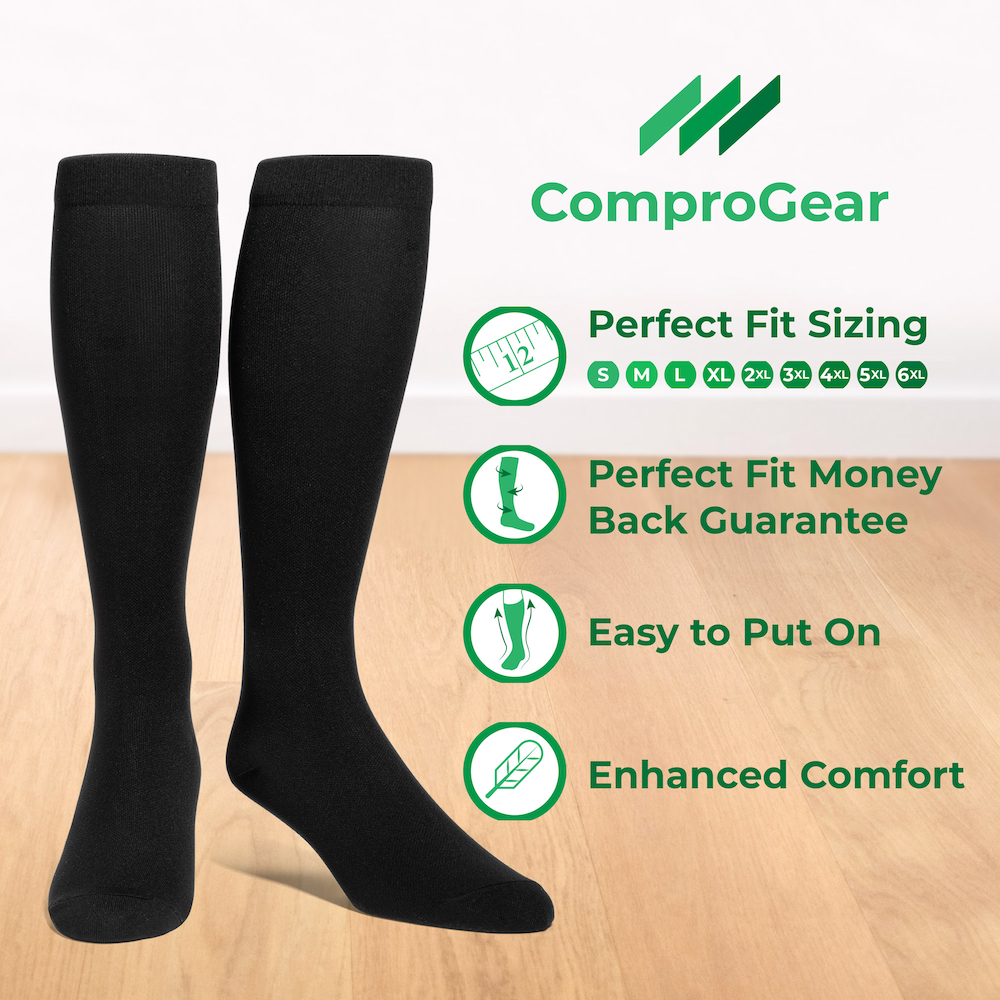Are Compression Socks During Pregnancy Dangerous?
They aren’t dangerous for pregnant women. Instead, compression socks during pregnancy boost circulation in your legs to prevent swelling.
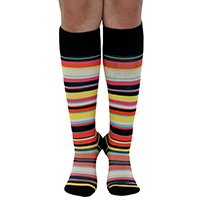
Most people think it’s not something they need, but the reality is, it’s something from which every expectant woman could benefit.
When you’re pregnant, the increased weight causes swelling in your legs whether you’re standing or sitting, which makes them ache and painful.
The most common health challenges during pregnancy are venous disorders. They account for most medical conditions in the world.
Our knee-high 20-30 mmHg compression socks provide true graduated compression, immediate relief, and sound sleep at night.
What Are Compression Socks?
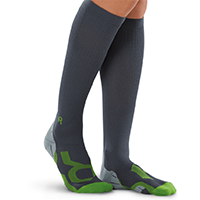
These are supportive legwear designed to squeeze the veins in your legs, making blood flow more easily and reduce the chance of you developing varicose legs.
Our compression stockings are specifically knit to be the tightest on your ankles and loose above. This carefully controlled pressure improves blood circulation.
What Conditions Do Compression Socks Treat?
There are two main conditions that can be managed with our high-quality compression stockings: venous inefficiency and varicose veins.
What is Venous Insufficiency?
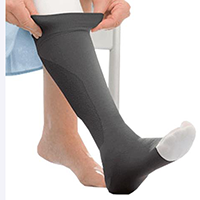
When most people hear the word vascular, they think of the most common condition called varicose veins, which affects a great number of pregnant women.
But varicose veins represents one form of chronic venous insufficiency over the entire spectrum of venous disease.
Varicose insufficiency occurs over a given period of time and often will continue. Venous or veins refers to those blood vessels that carry blood from your body back to your heart.
Insufficiency refers to malfunction of the veins in your legs. The veins have one-way valves that help prevent the blood in your legs from pooling due to the forces of gravity.
When your venous valves don’t function properly and allow blood to flow in the opposite direction towards your feet. Those valves are said to be insufficient.
Compression stockings during pregnancy help to remedy the symptoms of this condition. Here are some of the common symptoms to look out for:
- Dilated superficial veins in the lower extremity
- Aching and itching
- Varicosities over the lower leg and medial thigh
- Venous stasis ulcers (in prolonged cases)
What Are Varicose Veins?
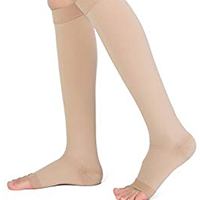
Varicose veins occur when you lose the elasticity and strength in your veins. Usually, this happens when you stand or sit too much, causing blood to pool below your vein valves.
The blood pool increases your blood pressure in the affected area, which causes your veins to bulge. Pregnancy makes you susceptible to varicose veins.
Your veins become blue when your blood lacks oxygen during pregnancy. This is an indication that the blood is not moving up towards your heart and into your lungs to pick more oxygen.
Varicose veins are painful and uncomfortable. Varicose veins are not a condition to ignore, since they can worse. So, you need compression stockings to manage them.
What is Deep Vein Thrombosis?
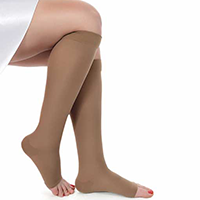
Abbreviated as DVT, this is a condition that causes blood to clot in your deep veins. DVT would normally occur in your left leg during pregnancy.
DVT can cause pulmonary embolism (a clot wedges itself in one of the pulmonary arteries), which is highly life-threatening.
The good news is that DVT and pulmonary embolism are treatable and manageable with maternity compression stockings-pregnancy.
The common symptoms of this condition are:
- A painful or heavy feeling in your leg
- Shortness of breath that can’t be explained
- Warmth or tenderness in the calf or thigh
- Fast breathing rate and heartbeat
- Chest pain and coughing blood
- The leg may swell slightly or severely
Selecting the Appropriate Compression Stockings
The criteria for selecting the best compression socks involves a number factors. Here are the main ones you should take into consideration.
Types of Compression Socks
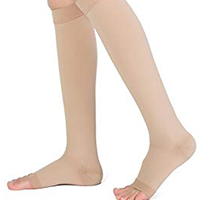
Compression stockings come in different types; from thigh-high to knee-high. You might be wondering which type works best to prevent DVT, PE or varicose veins.
When it comes to ease of use and effectiveness, we recommend knee-high over thigh-high compression stockings.

Our tests have show that thigh-high socks tend to be difficult to use with pregnant women. Knee-high compression socks during pregnancy have proven to be:
- More comfortable for expectant women
- An easier option to use
- Less likely to cause injury
- Just as effective as thigh-high
- Less expensive
What Compression Socks Strength is Right for You?
There’re different levels of compression available. Each compression rating is ideal for a specific condition and its symptoms.
Compression strength is normally measured in mmHg. The same unit of measurement is used to measure your blood pressure.
A higher mmHg value indicates a higher compression level, while a lower mmHg value indicates a lower compression level.
There are about five compression strength levels for treating venous problems in pregnant women and they include:
- 8-15 mmHg (Mild)
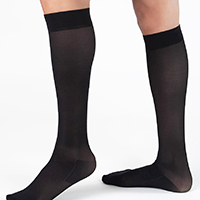
This compression rating provides mild pressure for proactive leg care. These socks are ideal for fatigued legs, moderate spider veins, and minor varicose veins.
They are suitable for when you are standing or sitting for extended duration. They offer relief for foot swelling, slight leg/ankle, and leg fatigue.
Graduated compression is usually greatest at the ankle of these stockings and decreases progressively up your leg to boost circulation.
Just make sure the pair you buy has reinforced and defined heel pockets that add orientation for a good fit and durability.
- 15-20 mmHg (Moderate)
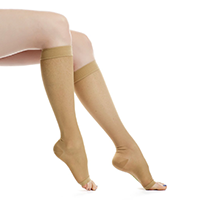
This compression rating provides gentle/moderate pressure, which is suitable for minor conditions. These socks apply the ideal amount of pressure on your feet and calf.
The 15-20 mmHg compression level enhances venous blood flow, stimulates delivery of oxygen to your muscles, prevent varicose veins, minimize blisters, and keep your feet dry.
They’re perfect for alleviating fatigue legs, deep vein thrombosis, minor swelling/edema, spider veins during pregnancy, and post vein procedure.
- 20-30mmHg (Firm)
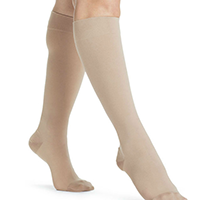
We sell knee-high 20-30 mmHg compression socks. Typically, these socks have to be recommended by a certified healthcare provider.
They apply compression strength that is recommended for pronounced conditions during maternity. These socks have defined heels for enhanced fit and soft top that won’t constrict your legs.
This compression strength is ideal for alleviating varicose veins, mild venous insufficiency, lymphedema, deep vein thrombosis, superficial thrombophlebitis, edema, and recurrence of venous ulcerations.
- 30-40 mmHg (Extra Firm)
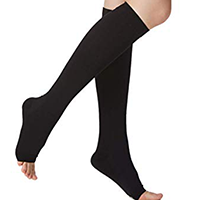
This compression strength should only be used when prescribed by a healthcare provider, and it is recommended for severe medical conditions.
A healthcare provider would recommend this compression strength for chronic venous insufficiency, post traumatic swelling, post venous ulcers, and severe edema.
- 40-50 mmHg (Severe)
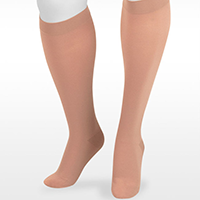
This is the highest compression strength that must be recommended by a physician. Stockings with this compression rating are ideal for severe lymphedema, chronic venous insufficiency, and deep vein thrombosis.
Comfort
Comfort is a very important consideration when shopping for compression stockings. You shouldn’t buy them without a doctor’s prescription.
This is so, since excessive pressure may cause discomfort. Most healthcare providers will prescribe or recommend mild, moderate, or firm compression socks during pregnancy.
Apart from the recommended pressure by doctor, you can also consider compression socks styles. There are many styles you can consider, including:
- Open Toe
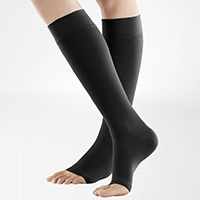
- Closed Toe
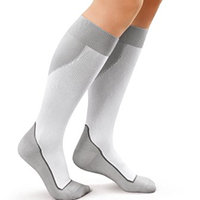
- Sheer
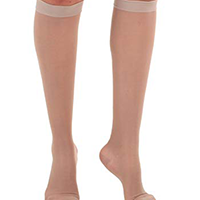
- Opaque
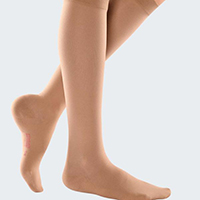
- Padded Foot
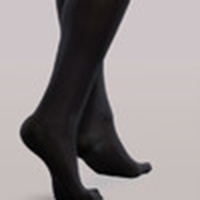
- No Foot
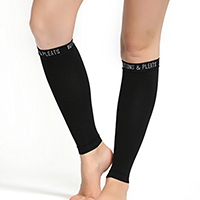
Open Toe vs. Closed Toe
Closed Toe socks are just like your traditional socks or stockings. This style is great, if you want full foot support and if you love wearing closed toe shoes.
These maternity socks provide you with the normal coverage you need and you don’t have to wear another pair of stockings or socks on top.
They’re also great for the colder months, since your whole toes and feet will be covered and comfortable.
With open toe, you get that full heel portion, which is really important if you are trying to capture those veins down by the ankle area.
This design provides you with a full heel up to the edge of your toes, exposing only the tip of your toes.
The open toe design makes this choice great for the summer months, since you can wear them comfortably with sandals.
Open toe compression socks give you a little more footwear flexibility. You would also prefer this design if you have toe-related conditions, such as an open sore or a bunion.
Construction and Material
Maternity compression stockings are produced on either flat or circular knitting machines. Class 1 to 3 stockings are made of circular knit; while class 2 to 4 are made of flat knit.
Stockings of class 3 and 4 are individually made to meet your doctor’s recommendation and leg measurements. They are knitted to anatomical shape.
Class 3 and 4 socks feature a very strong elastic yarn (double twisted), which guarantees very high compression values. They represent relatively heavy qualities.
A major component of maternity socks is the material and thickness in the composition. The material should not be a skin irritant and it should be tailored to your skin’s sensitivity.
The best compression socks material should provide protection from cold, heat, sweat, and other environmental foes to the feet.
The compression socks during pregnancy should be thick enough to provide the ideal compression, but not too thick to cause excessive pressure.
How to Measure for Compression Stockings
Before you measure, you should know that it is best to take your measurements when you first get up in the morning.
This ensures you don’t take sizes that are affected by swollen legs. You also want to make sure your measurements are taken while you are standing as it provides a more accurate reading.
Make sure all the measurements are cozy, and don’t take measurements when wearing ordinary socks or pants.
You need thigh, calf, ankle length and circumference for proper fitment. That is why proper measurement form compression stockings is important.
Here are the Steps to Follow:
Step One: Measure Your Ankle
Properly measure the perimeter of your ankles at the thinnest point, right above your ankle bone. Make sure there is no or minimal swelling.
Step Two: Measure Your Calf
In order to take the ideal size of your calf. Then you’ll have to measure the perimeter of your calf at the broadest point.
Step Three: Measure Your Thigh (If You Will Be Buying Thigh-High Stockings)
Make sure to measure your thigh at the widest point. Do this when your thighs are not swollen, preferably in the morning.
Step Four: Measure the Length
The last thing you will have to do is measure the correct length of either your knee-high or thigh-high stockings.
For knee-high socks, you’ll have to measure the length from the floor to the knee bend. For thigh-high stockings, you will want to measure from the floor up to your gluteal fold.
Conclusion
Compression stockings have come a long way. Today, colors and patterns are endless and there are a variety of sizes and styles.
Technology has allowed for greater levels of compression with less bulk, making prescribed maternity socks during pregnancy safer than ever.
We sell knee-high 20-30 mmHg compression socks. We can help you with recommendations on size, type, and compression rating that is right for you.
As you have seen there are many conditions you can treat with compression stockings. You just have to make sure you get the doctor’s prescribed choice.
